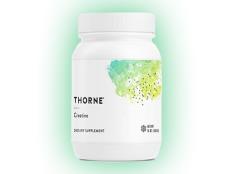
By clicking on the product links in this article, we may receive a commission fee at no cost to you, the reader. Sponsorships and affiliate commissions help support our research so we can help you find the best products. Read the full affiliate disclosure here.
Creatine is the single most studied exercise supplement due to its many benefits. It can be taken as a supplement on its own, or found mixed in with other ingredients aimed at improving exercise performance.
There's a lot of interest in the best time to take creatine, yet if you do a quick internet search, you'll likely find yourself overwhelmed with the contradictory information available.
If you, like many, are confused about if you should take creatine before or after a workout, or you just want to learn more about it, read on, because we are breaking down when to take creatine, how to creatine load, and what types of creatine are best for your goals. As you read on, here are list of high-quality creatine products we recommend:
What Is Creatine?
Should I take creatine before or after a workout? Let's first discuss what creatine is and how it works. Contrary to what some people (and websites) think, creatine is not an amino acid. It is however made from the amino acids arginine, glycine, and methionine.
Creatine is produced in the liver and kidneys, and is found mostly in the muscles. We can also take in creatine through our diet in the form of dairy, meats, seafood, and, of course, supplementation.
Why Take Creatine?
When taken as a dietary supplement, creatine can provide significant benefits for exercise performance and recovery. They include:
- Improved strength and power
- Improved muscle recovery time
- Reduced risk of injury
- Increased muscle mass
- Increased ability to exercise in the heat
Creatine may also offer additional neurological benefits such as concussion protection and improved outcomes after traumatic brain injury.
What is Creatine Loading and is It Necessary?
Creatine loading is the practice of consuming high doses of creatine, such as 20-25 grams per day for a period of 5-7 days. After that, the individual will continue taking creatine daily but at a much lower dose, usually 3-5 grams per day.
The idea behind creatine loading is to rapidly increase muscle stores of creatine in order to improve the benefits of the supplement itself. Research shows that the same benefit can take place using the maintenance dose of 3-5 grams of creatine per day, it just takes much longer to achieve maximum creatine potential. One study showed that potential can be met by creatine loading within six days versus 28 days when taking the daily maintenance dose.
Because you can get the same results either way, whether you choose to adopt creatine loading or not should be based on your individual goals. For example, if you are hoping to maximize creatine stores and your exercise potential very quickly, loading may be a better option for you. However, some people experience weight gain using the loading technique, so if this is something you would like to avoid, then taking a smaller dose regularly may be of more benefit to you.
Should I Take Creatine Before or After a Workout?
Now that you understand what creatine is and its many benefits, should you take it before or after a workout? Not surprisingly, it is a bit complicated.
The newest research tells us that studies regarding creatine timing are somewhat contradicting in nature because both options provide benefits.
For example, taking creatine right before a workout can result in peak creatinine concentration in the bloodstream during exercise. This is because exercise itself increases blood flow to the muscles, which then allows creatine-rich blood to flow into the muscles. This may be more effective at increasing the creatine load in the muscles, which allows for improved strength and power during the workout.
On the other hand, some studies demonstrate improvements in muscle growth and strength when taken after exercise. However, present flaws in the research limit their validity, such as having no placebo control group or lack of valid muscle growth measurements.
Another study compared the supplementation of creatine right before and right after exercise and found no difference in either of the two groups.
The Best Time to Take Creatine
Taking creatine before or after a workout doesn't seem to matter as much as taking creatine close to the time you work out.
Researchers have examined the difference in taking creatine within the workout window (immediately before or immediately after exercise), and taking it during different times of day. Taking creatine close to the workout, either right before or after, has resulted in significantly improved lean body mass and decreased fat percentage when compared with taking creatine at different times of the day.
Bottom line: The best time to take creatine is either right before or right after your workout.
Creatine On Rest Days
If the goal is to maintain muscle saturation of creatine, then creatine should be taken every day, including rest days. This is especially true if you are creatine loading.
If you recall, when creatine loading, creatine is taken at a dosage of 20-25 grams per day for 5-7 days. If you skip one of those days, the maximum capacity of creatine will not be met during the expected time frame.
This is also true if you are following a maintenance dose of 3-5 grams per day to maintain maximum creatine muscle saturation.
It is unlikely to cause detriment or a significant reduction in creatinine stores if you skip a day here and there. But with all things exercise and nutrition related, consistency is key.
What Form of Creatine Is Best?
The quest for the best form of creatine has been ongoing for years. The various forms of creatine include:
- Creatine monohydrate
- Creatine citrate
- Creatine ethyl ester
- Creatine serum
- Buffered creatine
- Creatine nitrate
Of all of these forms, creatine monohydrate is the most studied, and proven to be more easily taken up by muscles. For this reason, given the current research, creatine monohydrate is the best form to take. The majority of supplements on the market use this form, but it's always a good idea to be sure this is the form you're getting by reading the label.
Final Takeaway
Creatine is a powerhouse supplement providing many benefits ranging from increased strength and power to improved muscle recovery and reduced risk of injury. Not surprisingly, it's one of the most popular supplements available. Creatine monohydrate is considered the best form to take because studies have shown muscles are best able to absorb this form.
Finally, should you take creatine before or after a workout? The answer is: whichever works best for you. Creatine taken outside of the exercise window will not have the same beneficial effect as taking it within the window. So for best results, take your creatine directly before or after your workout to fully reap the benefits of this supplement.
What to Eat Before a Workout | Creatine Timing | Protein Timing | Best Pre-workout Supplements | Best Post-Workout Supplements | Best Creatine Supplements | Best Protein Powder Supplements | Best Peanut Butter | Best Greek Yogurt
These statements have not been evaluated by the Food and Drug Administration. This product is not intended to diagnose, treat, cure, or prevent any disease.







Discuss This Article